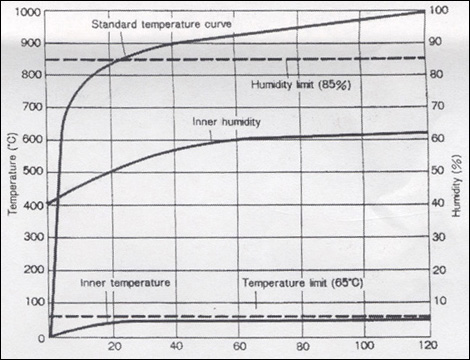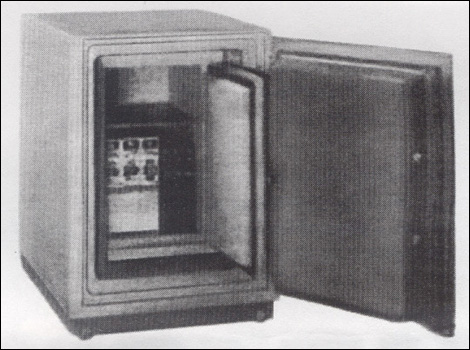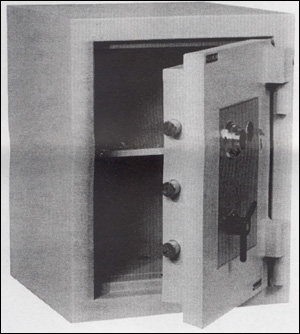 No matter what asset you want to protect, whether it be coins, currency, stamps, knives, autographs, etc., the subject of HUMIDITY always appears.
No matter what asset you want to protect, whether it be coins, currency, stamps, knives, autographs, etc., the subject of HUMIDITY always appears.
 Most people want to protect against burglary and fire, but there is always considerable concern about humidity.
Most people want to protect against burglary and fire, but there is always considerable concern about humidity.
 Since it is well known that humidity affects the condition of any item, the age old problem is how to control the humidity in your storage place, safe (or safe deposit box) so as not to lower the value of your investment, or have a negative effect on that which you are collecting.
Since it is well known that humidity affects the condition of any item, the age old problem is how to control the humidity in your storage place, safe (or safe deposit box) so as not to lower the value of your investment, or have a negative effect on that which you are collecting.
 There have been many attempts to accomplish this control, but many are not adequate because the understanding of humidity and the protection against it, is not a simple answer, BUT...there are ways!
There have been many attempts to accomplish this control, but many are not adequate because the understanding of humidity and the protection against it, is not a simple answer, BUT...there are ways!
 Poured concrete for a bank vault does not really prevent permeation of moisture through the walls with outside temperature variances. The morning offers minimum relative humidity problems, but as the day progresses, moisture increases in the air.
Poured concrete for a bank vault does not really prevent permeation of moisture through the walls with outside temperature variances. The morning offers minimum relative humidity problems, but as the day progresses, moisture increases in the air.
 This is a basic reason that many banks will not usually offer safe deposit vault holders’ policies against fire and moisture, because it can not be guaranteed or controlled. Keep in mind every time there is a wide range of temperature (inside or out), moisture will present itself within the inside of the container, safe or vault.
This is a basic reason that many banks will not usually offer safe deposit vault holders’ policies against fire and moisture, because it can not be guaranteed or controlled. Keep in mind every time there is a wide range of temperature (inside or out), moisture will present itself within the inside of the container, safe or vault.
 The answer is...at what point the relative humidity in the air surrounding the coin affects the item in question?
The answer is...at what point the relative humidity in the air surrounding the coin affects the item in question?
 Consider this: A commercial refrigerator in the summer will “sweat” on the outside. Why, as the surrounding temperature increases, moisture will collect, “condense” on the outside. Any increase in air temperature will draw out moisture. This will happen also in a closed location as in a safe, deposit box, etc.
Consider this: A commercial refrigerator in the summer will “sweat” on the outside. Why, as the surrounding temperature increases, moisture will collect, “condense” on the outside. Any increase in air temperature will draw out moisture. This will happen also in a closed location as in a safe, deposit box, etc.
 The true control of moisture can only be accomplished by not allowing ambient (surrounding) temperature to suddenly increase.
The true control of moisture can only be accomplished by not allowing ambient (surrounding) temperature to suddenly increase.
 This is one of the reasons that testing on containers (safes) accepted ratings emphasize that the “internal” temperature inside a safe shall not go higher than, for example, 350° F., while the outside temperature is maintained for 1850° F. for a constant 2 hours!
This is one of the reasons that testing on containers (safes) accepted ratings emphasize that the “internal” temperature inside a safe shall not go higher than, for example, 350° F., while the outside temperature is maintained for 1850° F. for a constant 2 hours!
 This will protect the inside contents from fire temperature, time and humidity with a safe:
This will protect the inside contents from fire temperature, time and humidity with a safe:
(See the chart below for temperature humidity and time relationships.)

 Now the question is HOW much moisture is tolerable without causing damage?
Now the question is HOW much moisture is tolerable without causing damage?
 UL testing states that a proper safe tested to meet their standards during a fire for the stated duration will not exceed a relative humidity of 85%. This perhaps does not meet your requirements. This is a threshold point. It may be less at associated temperatures.
UL testing states that a proper safe tested to meet their standards during a fire for the stated duration will not exceed a relative humidity of 85%. This perhaps does not meet your requirements. This is a threshold point. It may be less at associated temperatures.
 The problem now is HOW to keep the relative humidity inside a container (safe) l-o-w-e-r than the accepted ratings.
The problem now is HOW to keep the relative humidity inside a container (safe) l-o-w-e-r than the accepted ratings.
 The solutions are quite simple, but your particular location and method of fighting unacceptable humidity will vary.
The solutions are quite simple, but your particular location and method of fighting unacceptable humidity will vary.
 With respect to the very sime case. A coin collector lives near the ocean. The proximity of high relative humidity always is present each time the safe door is opened.
With respect to the very sime case. A coin collector lives near the ocean. The proximity of high relative humidity always is present each time the safe door is opened.
 If the door (which of course is not hermetically sealed) is not opened frequently, the moisture in the air will cling to the safe walls and contents, and keep building up...total disaster...as the ambient temperature changes. Thus you have unwanted moisture because of a high moisture ambient air, coupled with external temperature changes causing a higher water content, added to this the uncirculated air inside.
If the door (which of course is not hermetically sealed) is not opened frequently, the moisture in the air will cling to the safe walls and contents, and keep building up...total disaster...as the ambient temperature changes. Thus you have unwanted moisture because of a high moisture ambient air, coupled with external temperature changes causing a higher water content, added to this the uncirculated air inside.
 This happens to a heavy, extra thick steel burglar safe that sweats on the inside (steel will draw great amounts of water from the atmosphere, inside and out).
This happens to a heavy, extra thick steel burglar safe that sweats on the inside (steel will draw great amounts of water from the atmosphere, inside and out).
Suggestion
1. Allow the inside air to circulate by either openeing it frequently and...
2. Add a moisture drawing desiccant. These are crystals that absorb moisture and can be heated in an oven to dry out and be reused. Devices, such as a Perma Pack can control relative humidity to below 40%.
3. Or, use a special electric heating rod. It is available under the name of “Dri-Rod” or “Golden Rod.” It heats the air inside the safe. A temperature rise inside a safe at the bottom to keep the air dry circulating it to the top. It only draws about 7 watts and keeps a three degree control. A 12” rod is adequate for a 35 cubic foot cap safe.
4. Buy a new safe of composite construction to not only protect against burglar tool and torch attack, also offer adequate fire protection without transferring moisture through the safe doors and walls during a fire.
 [Fire safes, even though they were originally tested at a time of construction, may have old insulation that is no longer effective because of aging, or made of a moisture holding character to keep moisture within the wall, and then spew out a fine mist to wet the interior contents to keep the contents from burning.] [you can always detect these kind of safes, know as “weepers”, the moisture within the walls or door will cause rust marks on the door frames].
[Fire safes, even though they were originally tested at a time of construction, may have old insulation that is no longer effective because of aging, or made of a moisture holding character to keep moisture within the wall, and then spew out a fine mist to wet the interior contents to keep the contents from burning.] [you can always detect these kind of safes, know as “weepers”, the moisture within the walls or door will cause rust marks on the door frames].
 This may seem simple, but it is the best solution, for these cases or existing safes.
This may seem simple, but it is the best solution, for these cases or existing safes.
 If you ask an expert, many times you will not get an answer as to WHAT LEVEL OF RELATIVE HUMIDITY CAN I ALLOW?
If you ask an expert, many times you will not get an answer as to WHAT LEVEL OF RELATIVE HUMIDITY CAN I ALLOW?
 The answer is 85% warranted by UL fire tests. It could be lower but it depends on:
The answer is 85% warranted by UL fire tests. It could be lower but it depends on:
1. The relative humidity in the ambient air at that time.
2. It depends, on the length of time the fire burns (response time, cool down time, etc.)
 This has been not acceptable to many concerned dealers, investors and collectors who not only are concerned with their own inventments but also their client’s investments.
This has been not acceptable to many concerned dealers, investors and collectors who not only are concerned with their own inventments but also their client’s investments.
 This has prompted a new age of protection. Many data storage systems cannot tolerate a humidity factor at 85%. Discs are lost, memory is destroyed. A new breed of safe has entered the market. But the humidity is kept to acceptable levels.
This has prompted a new age of protection. Many data storage systems cannot tolerate a humidity factor at 85%. Discs are lost, memory is destroyed. A new breed of safe has entered the market. But the humidity is kept to acceptable levels.
 This is called a “DATA SAFE”. This safe is rated 150° F or 125° F to protect media specifically. This particular temperature rise (as we have discussed) again limits a sudden temperature rise keeping unwanted moisture away.
This is called a “DATA SAFE”. This safe is rated 150° F or 125° F to protect media specifically. This particular temperature rise (as we have discussed) again limits a sudden temperature rise keeping unwanted moisture away.

 These particular safes are primarily constructed as a “safe-within-a-safe”, (although there are some built with single door and wall construction). If a fire burns at 1850° F for two hours the inside temperature does not go above 150° F/ 125° F. It is great for magnetic media that cannot handle moisture but these safes can be rather expensive as compared to a UL TL-30 composite safe.
These particular safes are primarily constructed as a “safe-within-a-safe”, (although there are some built with single door and wall construction). If a fire burns at 1850° F for two hours the inside temperature does not go above 150° F/ 125° F. It is great for magnetic media that cannot handle moisture but these safes can be rather expensive as compared to a UL TL-30 composite safe.
 My suggested solution is that you consider the following:
My suggested solution is that you consider the following:
1. Obtain a safe that is very secure from any burglar torch, or tool attack.
2. Make sure that this safe is made of a composite construction (new state-of-the-art) on all six sides with appropriate locking and relocking devices that offers no, or minimal, moisture transference through its walls or door.
3. With respect to fire, make sure you have an UL rating to give you basic fire and humidity protection as the external temperature rises.

4. If you have rare coins where you cannot allow any humidity problems add another small safe inside with a 2 hour rating.
The inside of the composite 2 hour rated safe, will at the worst, only see 350° F with a 1840° F external safe temperature. The inside safe will only see 350° F on its outside (at the worst) and subsequently, the inside of the small safe will have virtually no temperature change, i.e., no moisture added to the air inside.
This has the same effect as the “data safe” but offers you:
1. Adequate Burglar Protection: It offers tool and torch protection against attacks on lock, door and safe body by having composite construction that consists of various nuggets of dissimilar metals, steel filings, special metallic rods, etc., that will cause the burglar to keep changing tools, drills and saws to continue the attack. Also this amalgamate is encased with high stress concrete, with drill offset bars, etc.
2. Adequate Fire Protection: By the fact that the safe is of composite construction, the concrete barrier offers a perfect insulation.
3. Adequate Humidity Protection: Also by the reason this composite is made up of concrete, it will resist moisture and moisture transference through the walls.
4. Flexibility: You can locate the inside safe anywhere within the large composite safe.
5. Large Space Capacity: You will be able to obtain a large internal capacity with this arrangement.
6. Reasonable Low Cost (vs. a Data Safe): A Data Safe will run approximately 1 1/2 - 2 times the cost of using a Composite with a fire safe inside.

